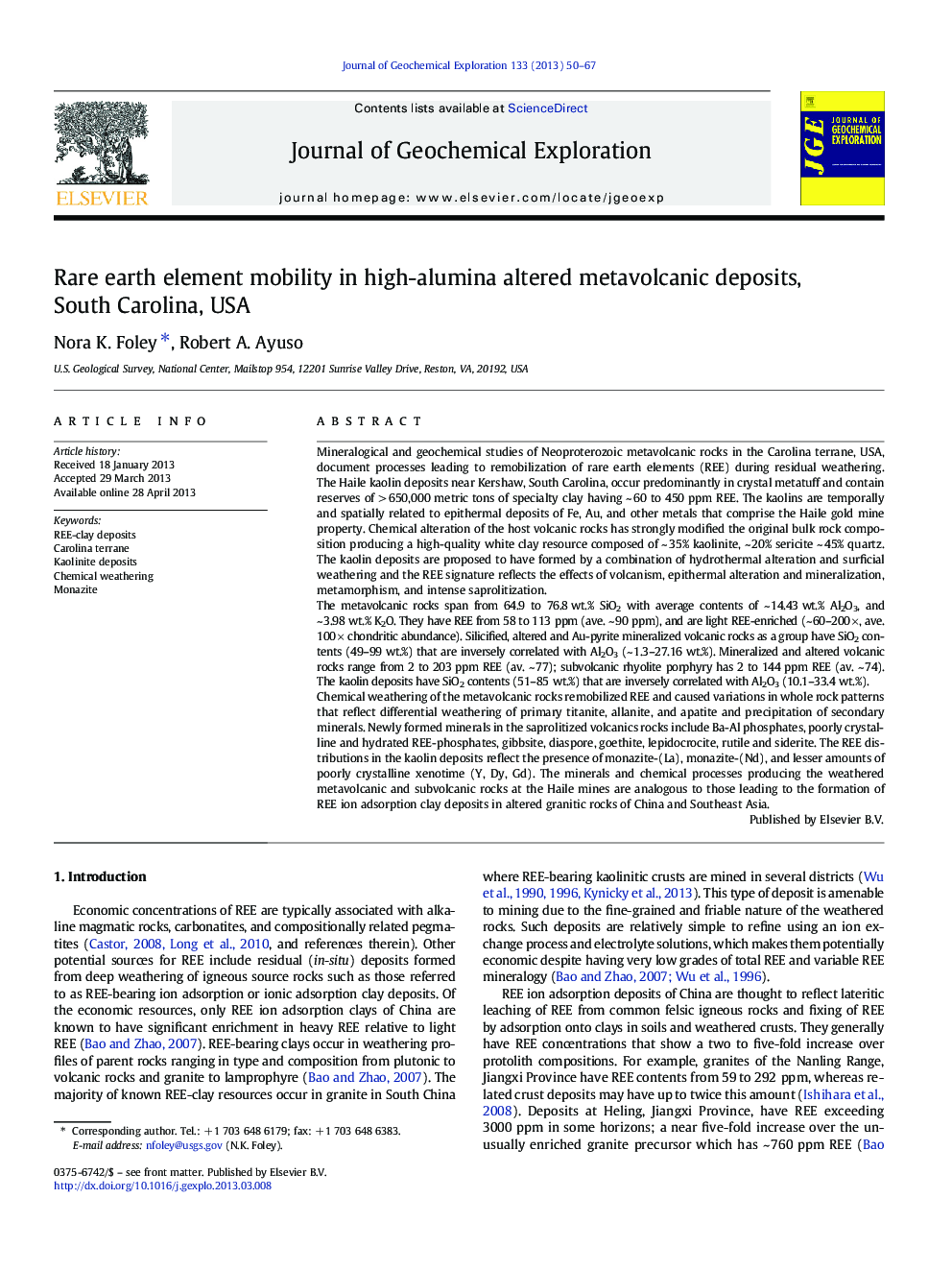| کد مقاله | کد نشریه | سال انتشار | مقاله انگلیسی | نسخه تمام متن |
|---|---|---|---|---|
| 4457532 | 1620924 | 2013 | 18 صفحه PDF | دانلود رایگان |

• Metavolcanic rocks of the southeastern USA host REE-bearing kaolin deposits.
• The deposits formed by hydrothermal and chemical weathering processes.
• Mobility of REE in the clay deposits is documented by changes in bulk geochemistry.
• REE distributions in kaolins are controlled primary by precipitation of monazite.
• A model for REE-enriched clay deposits in southeast United States is proposed.
Mineralogical and geochemical studies of Neoproterozoic metavolcanic rocks in the Carolina terrane, USA, document processes leading to remobilization of rare earth elements (REE) during residual weathering. The Haile kaolin deposits near Kershaw, South Carolina, occur predominantly in crystal metatuff and contain reserves of > 650,000 metric tons of specialty clay having ~ 60 to 450 ppm REE. The kaolins are temporally and spatially related to epithermal deposits of Fe, Au, and other metals that comprise the Haile gold mine property. Chemical alteration of the host volcanic rocks has strongly modified the original bulk rock composition producing a high-quality white clay resource composed of ~ 35% kaolinite, ~ 20% sericite ~ 45% quartz. The kaolin deposits are proposed to have formed by a combination of hydrothermal alteration and surficial weathering and the REE signature reflects the effects of volcanism, epithermal alteration and mineralization, metamorphism, and intense saprolitization.The metavolcanic rocks span from 64.9 to 76.8 wt.% SiO2 with average contents of ~ 14.43 wt.% Al2O3, and ~ 3.98 wt.% K2O. They have REE from 58 to 113 ppm (ave. ~ 90 ppm), and are light REE-enriched (~ 60–200 ×, ave. 100 × chondritic abundance). Silicified, altered and Au-pyrite mineralized volcanic rocks as a group have SiO2 contents (49–99 wt.%) that are inversely correlated with Al2O3 (~ 1.3–27.16 wt.%). Mineralized and altered volcanic rocks range from 2 to 203 ppm REE (av. ~ 77); subvolcanic rhyolite porphyry has 2 to 144 ppm REE (av. ~ 74). The kaolin deposits have SiO2 contents (51–85 wt.%) that are inversely correlated with Al2O3 (10.1–33.4 wt.%).Chemical weathering of the metavolcanic rocks remobilized REE and caused variations in whole rock patterns that reflect differential weathering of primary titanite, allanite, and apatite and precipitation of secondary minerals. Newly formed minerals in the saprolitized volcanics rocks include Ba-Al phosphates, poorly crystalline and hydrated REE-phosphates, gibbsite, diaspore, goethite, lepidocrocite, rutile and siderite. The REE distributions in the kaolin deposits reflect the presence of monazite-(La), monazite-(Nd), and lesser amounts of poorly crystalline xenotime (Y, Dy, Gd). The minerals and chemical processes producing the weathered metavolcanic and subvolcanic rocks at the Haile mines are analogous to those leading to the formation of REE ion adsorption clay deposits in altered granitic rocks of China and Southeast Asia.
Journal: Journal of Geochemical Exploration - Volume 133, October 2013, Pages 50–67